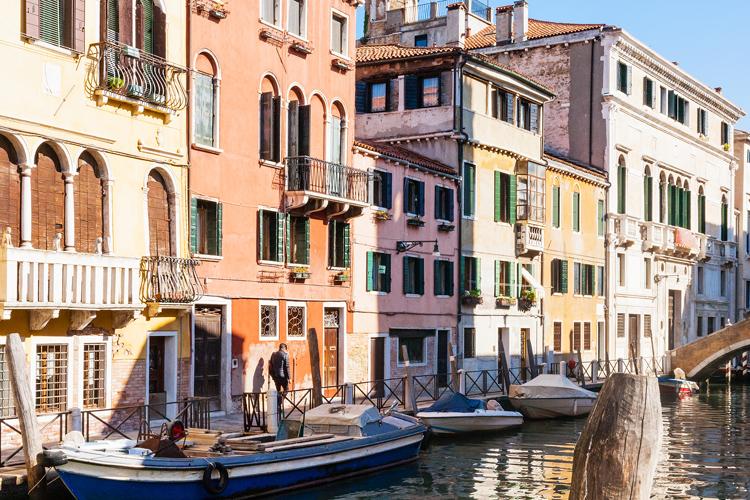Venice’s ‘Neighborhoods’
ITA:

Getting lost in Venice is easy, but it’s also part of the city’s charms.
Venice is divided into six sestieri, three on each bank of the Canal Grande. This subdivision dates back to Venice’s origins. Each sestiere has its own street numbers, which, as you may guess, can lead to some confusion!
Let’s see what the six sestieri are.
Castello – overlooking the sea, Castello is the most easterly sestiere. Its name derives from the fortress that once stood in the area as a defense post, around which the neighborhood grew. Castello is where the Arsenale, a complex of former shipyards and armories, once the heart of Venice’s thriving naval industry, is located.
San Marco – the political and religious heart of the city since Venice’s foundation, it takes its name from the Basilica of the same name. It is the original nucleus of the city. San Marco is bordered to the north by Cannaregio and to the east by Castello; it connects to San Polo via the Rialto Bridge and to Dorsoduro via Accademia Bridge.
Cannaregio – this is the area closer to the mainland, and its name may originate from this reason, as the ‘Canal Regio’ was the one used to reach the mainland; or it may be due to that fact that there was once a marshy area with many rushes, canneti in Italian. Cannaregio is the second largest of the sestieri after Castello, and the most populous. It occupies almost entirely the part of the city to the north of the Canal Grande.
San Polo – the smallest of the sestieri, concentrated in a bend of the Grand Canal, it is connected to San Marco though the famous Rialto Bridge. It takes its name from the Church of San Polo and is at the center of Venice. It is home to the popular Rialto food market, where Venetians go shopping for fresh fish, vegetables, fruit and more.
Santa Croce – it takes its name from the church and monastery of the same name, which were demolished in the 19th century. It has undergone several changes in the 20th century, becoming the car and bus hub of the lagoon city; this is where Piazzale Roma, home to Venice's bus station and car parks, Tronchetto, a car park for tourists, and the main port are located.
Dorsoduro – this is the southern area of the city and takes its name from the compact sand dunes that made the ground harder (dorso duro = hard back) and less swampy than in other parts of Venice; in the past, the wood that came from the Cadore forests and was used to build boats, was unloaded on its massive sand pier.
Perdersi a Venezia è facile, ma è anche parte del fascino della città.
Venezia è divisa in sei sestieri, tre su ogni sponda del Canal Grande. Questa suddivisione risale alle origini di Venezia. Ogni sestiere ha i suoi numeri civici, il che, come puoi immaginare, può causare una certa confusione!
Vediamo quali sono i sei sestieri di Venezia.
Castello – affacciato sul mare, il Castello è il sestiere più a est. Il suo nome deriva dalla fortezza difensiva che sorgeva qui, e attorno alla quale il quartiere è cresciuto. Castello è dove si trova l’Arsenale, un complesso di ex cantieri navali e armerie, in passato il cuore della florida industria navale veneziana.
San Marco - il cuore politico e religioso della città sin dalla fondazione di Venezia, prende il nome dalla Basilica omonima. E’ il nucleo originario della città. San Marco è delimitata a nord da Cannaregio e ad est da Castello; si collega a San Polo tramite il Ponte di Rialto e a Dorsoduro tramite il Ponte dell'Accademia.
Cannaregio - questa è la zona più vicina alla terraferma, e il suo nome può essere dovuto a questa ragione, in quanto il 'Canal Regio' era quello usato per raggiungere la terraferma; o può essere dovuto al fatto che una volta c'era una zona paludosa con molti canneti. Cannaregio è il più grande dei sestieri dopo Castello, e il più popoloso. Occupa quasi interamente la parte della città a nord del Canal Grande.
San Polo - il più piccolo dei sestieri, concentrato in una curva del Canal Grande, è collegato a San Marco tramite il famoso Ponte di Rialto. Prende il nome dalla Chiesa di San Polo ed è al centro di Venezia. E' sede del famoso mercato alimentare di Rialto, dove i veneziani fanno la spesa per comprare pesce fresco, verdura, frutta e molto altro.
Santa Croce - prende il nome dalla chiesa e dal monastero omonimi, demoliti nel 19° secolo. Ha subito diversi cambiamenti nel 20° secolo, diventando il principale snodo viario della città; è qui che si trovano Piazzale Roma, il terminal degli autobus e zona di parcheggi per macchine, Tronchetto, un parcheggio per i turisti, e il porto principale.
Dorsoduro – si trova nella zona meridionale della città e prende il nome dalle dune di sabbia compatta che hanno reso il terreno più stabile e meno paludoso che in altre parti di Venezia; in passato, il legno che arrivava dalle foreste del Cadore e veniva utilizzato per costruire le barche, veniva scaricato sul suo massiccio molo in sabbia.











